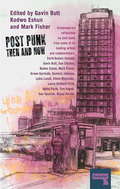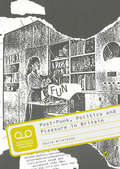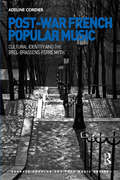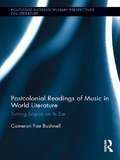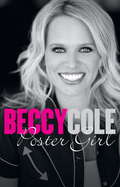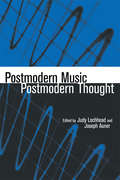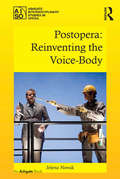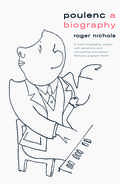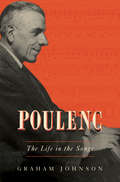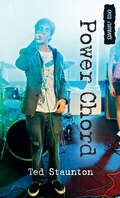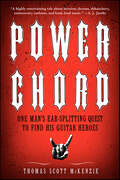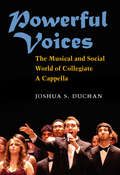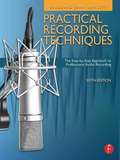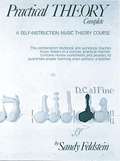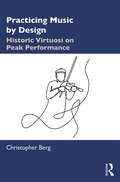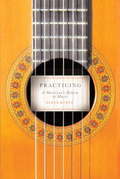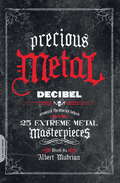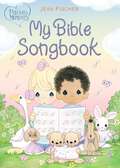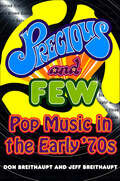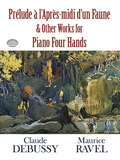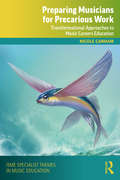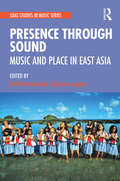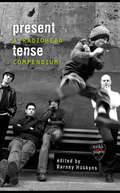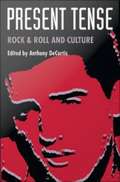- Table View
- List View
Post-Punk Then and Now
by Mark Fisher Kodwo Eshun Gavin Butt Green Gartside Sue ClaytonWhat were the conditions of possibility for art and music-making before the era of neoliberal capitalism? What role did punk play in turning artists to experiment with popular music in the late 1970s and early 1980s? And why does the art and music of these times seem so newly pertinent to our political present, despite the seeming remoteness of its historical moment? Focusing upon the production of post-punk art, film, music, and publishing, this book offers new perspectives on an overlooked period of cultural activity, and probes the lessons that might be learnt from history for artists and musicians working under 21st century conditions of austerity. Contemporary reflections by those who shaped avant-garde and contestatory culture in the UK, US, Brazil and Poland in the 1970s and 1980s. Alongside these are contributions by contemporary artists, curators and scholars that provide critical perspectives on post-punk then, and its generative relation to the aesthetics and politics of cultural production today.
Post-Punk, Politics and Pleasure in Britain
by David WilkinsonAs the Sex Pistols were breaking up, Britain was entering a new era. Punk's filth and fury had burned brightly and briefly; soon a new underground offered a more sustained and constructive challenge. As future-focused, independently released singles appeared in the wake of the Sex Pistols, there were high hopes in magazines like NME and the DIY fanzine media spawned by punk. Post-Punk, Politics and Pleasure in Britain explores how post-punk's politics developed into the 1980s. Illustrating that the movement's monochrome gloom was illuminated by residual flickers of countercultural utopianism, it situates post-punk in the ideological crossfire of a key political struggle of the era: a battle over pleasure and freedom between emerging Thatcherism and libertarian, feminist and countercultural movements dating back to the post-war New Left. Case studies on bands including Gang of Four, The Fall and the Slits and labels like Rough Trade move sensitively between close reading, historical context and analysis of who made post-punk and how it was produced and mediated. The book examines, too, how the struggles of post-punk resonate down to the present.
Post-War French Popular Music: Cultural Identity and the Brel-Brassens-Ferré Myth (Ashgate Popular and Folk Music Series)
by Adeline CordierJacques Brel, Georges Brassens and Léo Ferré are three emblematic figures of post-war French popular music who have been constantly associated with each other by the public and the media. They have been described as the epitome of chanson, and of 'Frenchness'. But there is more to the trio than a musical trinity: this new study examines the factors of cultural and national identity that have held together the myth of the trio since its creation. This book identifies the combination of cultural and historical circumstances from which the works of these three singers emerged. It presents an innovative analysis of the correlation between this iconic trio and the evolution of national myths that nurtured the cultural aspirations of post-war French society. It explores the ways in which Brel, Brassens and Ferré embody the myth of the left-wing intellectual and of the authentic 'Gaul' spirit, and it discusses the ambiguous attitude of post-war French society towards gender relations. The book takes an original look at the trio by demonstrating how it illustrates the popular representation of a key issue of French national identity: the paradoxical aspiration to both revolution and the maintenance of the status quo.
Postcolonial Readings of Music in World Literature (Routledge Interdisciplinary Perspectives on Literature)
by Cameron Fae BushnellThis book reads representations of Western music in literary texts to reveal the ways in which artifacts of imperial culture function within contemporary world literature. Bushnell argues that Western music’s conventions for performance, composition, and listening, established during the colonial period, persist in postcolonial thought and practice. Music from the Baroque, Classical, and Romantic periods (Bach through Brahms) coincides with the rise of colonialism, and Western music contains imperial attitudes and values embedded within its conventions, standards, and rules. The book focuses on the culture of classical music as reflected in the worlds of characters and texts and contends that its effects outlast the historical significance of the real composers, pieces, styles, and forms. Through examples by authors such as McEwan, Vikram Seth, Bernard MacLaverty, Chang-rae Lee, and J.M. Coetzee, the book demonstrates how Western music enters narrative as both acts of history and as structures of analogy that suggest subject positions, human relations, and political activity that, in turn, describes a postcolonial condition. The uses to which Western music is put in each literary text reveals how European art music of the seventeenth through the nineteenth centuries is read and misread by postcolonial generations, exposing mostly hidden cultural structures that influence our contemporary understandings of social relations and hierarchies, norms for resolution and for assigning significance, and standards of propriety. The book presents strategies for thinking anew about the persistence of cultural imperialism, reading Western music simultaneously as representative of imperial, cultural dominance and as suggestive of resistant structures, forms, and practices that challenge the imperial hegemony.
Poster Girl
by Beccy ColeBeccy Cole's inspirational memoir from the heart of Australian country music.Beccy Cole has country music in her blood. Daughter of a country music star, Carole Sturtzel, she is one of the most popular country singer-songwriters in Australia today. This is the story of her life - in her own words.At fourteen, Beccy was performing in her mother's group, Wild Oats. By her late teens, Beccy had teamed up with the Dead Ringer Band - Kasey Chambers' family band - and had attracted the attention of the country music world by winning the Star Maker quest: the same award that started the careers of Keith Urban, Lee Kernaghan, James Blundell and Gina Jeffreys. It was just the first of many awards and accolades for this multitalented woman with a big heart.With refreshing candour, Beccy shares her story: leaving everything she knew to pursue her dream, making a name for herself with her own band; her marriage and motherhood; her subsequent divorce, becoming a single mother and maintaining the nurturing love of family. Performing for the Australian troops in Afghanistan. Coming out, and what it has meant for her and her fans. Taking control of her own life - and finding love.Heartfelt and honest, Poster Girl is the inspirational memoir of a strong woman who epitomises the authentic spirit of country music, and of Australia.
Postmodern Music/Postmodern Thought (Studies In Contemporary Music And Culture Ser. #Vol. 4)
by Joseph Auner Judy LochheadWhat is postmodern music and how does it differ from earlier styles, including modernist music? What roles have electronic technologies and sound production played in defining postmodern music? Has postmodern music blurred the lines between high and popular music? Addressing these and other questions, this ground-breaking collection gathers together for the first time essays on postmodernism and music written primarily by musicologists, covering a wide range of musical styles including concert music, jazz, film music, and popular music. Topics include: the importance of technology and marketing in postmodern music; the appropriation and reworking of Western music by non-Western bands; postmodern characteristics in the music of Górecki, Rochberg, Zorn, and Bolcom, as well as Björk and Wu Tang Clan; issues of music and race in such films as The Bridges of Madison County, Batman, Bullworth, and He Got Game; and comparisons of postmodern architecture to postmodern music. Also includes 20 musical examples.
Postopera: Reinventing The Voice-body (Ashgate Interdisciplinary Studies in Opera)
by Jelena NovakBoth in opera studies and in most operatic works, the singing body is often taken for granted. In Postopera: Reinventing the Voice-Body, Jelena Novak reintroduces an awareness of the physicality of the singing body to opera studies. Arguing that the voice-body relationship itself is a producer of meaning, she furthermore posits this relationship as one of the major driving forces in recent opera. She takes as her focus six contemporary operas - La Belle et la Bête (Philip Glass), Writing to Vermeer (Louis Andriessen, Peter Greenaway), Three Tales (Steve Reich, Beryl Korot), One (Michel van der Aa), Homeland (Laurie Anderson), and La Commedia (Louis Andriessen, Hal Hartley) - which she terms 'postoperas'. These pieces are sites for creative exploration, where the boundaries of the opera world are stretched. Central to this is the impact of new media, a de-synchronization between image and sound, or a redefinition of body-voice-gender relationships. Novak dissects the singing body as a set of rules, protocols, effects, and strategies. That dissection shows how the singing body acts within the world of opera, what interventions it makes, and how it constitutes opera’s meanings.
Poulenc: A Biography
by Roger NicholsAn authoritative account of the life and work of Francis Poulenc, one of the most prolific and striking figures in twentieth-century classical music Francis Poulenc is a key figure in twentieth-century classical music, as well as an unorthodox and striking individual. Roger Nichols draws upon Poulenc's music and other primary sources to write an authoritative life of this great artist. Although associated with five other French composers in what came to be called “Les Six”, Poulenc was very much sui generis in personality and in his music, where he excelled over a wide repertoire—opera, songs, ballet scores, chamber works, piano pieces, sacred and secular choral works, orchestral works and concertos. This book fully covers this wide range, while also describing the vicissitudes of Poulenc's life and the many important relationships he had with major figures such as Satie, Ravel, Stravinsky, Diaghilev, Cocteau and others.
Poulenc: The Life In The Songs
by Graham JohnsonOne of the greatest modernist composers comes alive in this illuminating biography, a must-have for musicians and music-lovers alike. Francis Poulenc (1899–1963) is widely acknowledged as one of the twentieth century’s most significant masters of vocal music —solo, choral, and operatic— quite apart from his achievements in instrumental spheres. But what it cost him, and the determined bravery it took for his unusual talent to thrive, has always been underestimated. In this seminal biography, which will serve as the definitive guide to the songs, acclaimed collaborative pianist Graham Johnson shows that it is in Poulenc’s extraordinary songs, and seeing how they fit into his life —which included crippling guilt on account of his sexuality— that we discover Poulenc heart and soul. With Jeremy Sams’s vibrant new song translations, the first in over forty years, and the insight that comes from a lifetime of performing this music, Johnson provides an essential volume for singers, pianists, listeners, and readers interested in the artistic milieu of modernism in the first half of the twentieth century.
Power Chord: (power Chord) (Orca Currents)
by Ted StauntonAt a Battle of the Bands event, Ace and his best friend Denny notice that girls like musicians, no matter how dorky the dudes might be. Having, so far, been severely challenged when it comes to meeting girls, they decide to start a band. Ace discovers that he loves playing guitar and electric bass. While Denny tweets their every move and their clean-freak drummer, Pig, polishes everything in sight, Ace tries to write a song that will win at the next local teen songwriting contest. It's more difficult than he thought it would be. When Denny brings a great tune to rehearsal, Ace is devastated that Denny, who rarely practices, is a better songwriter than he is. The contest is only days away when Ace discovers that Denny stole the song, and Ace has to decide if winning is worth the lie. Also available in French.
Power Chord: One Man's Ear-Splitting Quest to Find His Guitar Heroes
by Thomas Scott McKenziePower Chord is the story of one man’s epic pilgrimage to gain rock enlightenment from the gods and guitar heroes of the Golden Age of heavy metal. Author Scott McKenzie set off to make contact with the legendary metal superstars he worshipped in his rural Kentucky youth—men like George Lynch of Dokken, Glen Tipton of Judas Priest, and Ace Frehley of KISS—hoping to gain wisdom and a better understanding of the electric guitar mystique. The result is a veritable treasure trove of enthralling behind-the-scenes stories and “where are they now” revelations that will delight anyone who has ever felt a Mötley Crüe, Guns ’N’ Roses, or Black Sabbath song reach out from the speakers and grab them by the ears.
Powerful Voices: The Musical and Social World of Collegiate a Cappella
by Joshua S. DuchanCollegiate a cappella, part of a long tradition of unaccompanied singing, is known to date back on American college campuses to at least the colonial era. Considered in the context of college glee clubs, barbershop quartets, early-twentieth-century vocal pop groups, doo-wop groups, and late-twentieth-century a cappella manifestations in pop music, collegiate a cappella is an extension of a very old tradition of close harmony singing---one that includes but also goes beyond the founding of the Yale Whiffenpoofs. Yet despite this important history, collegiate a cappella has until now never been the subject of scholarly examination. InPowerful Voices: The Musical and Social World of Collegiate A Cappella, Joshua S. Duchan offers the first thorough accounting of the music's history and reveals how the critical issues of sociability, gender, performance, and technology affect its music and experience. Just as importantly, Duchan provides a vital contribution to music scholarship more broadly, in several important ways: by expanding the small body of literature on choruses and amateur music; by addressing musical and social processes in a field where the vast majority of scholarship focuses on individuals and their products; and by highlighting a musical context long neglected by musicologists---the college campus. Ultimately,Powerful Voicesis a window on a world of amateur music that has begun to expand its reach internationally, carrying this uniquely American musical form to new global audiences, while playing an important role in the social, cultural, and musical education of countless singers over the last century.
Practical Recording Techniques
by Bruce BartlettHands-on practical guide covering all aspects of recording, ideal for beginning and intermediate recording engineers, producers, musicians and audio enthusiasts. Filled with tips and shortcuts, this book offers advice on equipping a home studio (both low-budget and advanced), suggestions for set-up, acoustics, choosing monitor speakers, and preventing hum. This best-selling guide also tells how to judge recordings and improve them to produce maximum results. New material covered in the 5th edition to include: * complete revision and update of digital media sections* new section on mixing tips* new section on podcasts and file sharing* new section equipment and connector levels* new section function and connector types* new section on digital metering* new section exporting projects from other studios* new photos
Practical Theory Complete: A Self-Instruction Music Theory Course
by Sandy FeldsteinA combination text and workbook in three volumes. All areas of music theory are covered in a concise and practical manner and each level contains 28 lessons.
Practicing Music by Design: Historic Virtuosi on Peak Performance
by Christopher BergPracticing Music by Design: Historic Virtuosi on Peak Performance explores pedagogical practices for achieving expert skill in performance. It is an account of the relationship between historic practices and modern research, examining the defining characteristics and applications of eight common components of practice from the perspectives of performing artists, master teachers, and scientists. The author presents research past and present designed to help musicians understand the abstract principles behind the concepts. After studying Practicing Music by Design, students and performers will be able to identify areas in their practice that prevent them from developing. The tenets articulated here are universal, not instrument-specific, borne of modern research and the methods of legendary virtuosi and teachers. Those figures discussed include: Luminaries Franz Liszt and Frederic Chopin Renowned performers Anton Rubinstein, Mark Hambourg, Ignace Paderewski, and Sergei Rachmaninoff Extraordinary teachers Theodor Leschetizky, Rafael Joseffy, Leopold Auer, Carl Flesch, and Ivan Galamian Lesser-known musicians who wrote perceptively on the subject, such as violinists Frank Thistleton, Rowsby Woof, Achille Rivarde, and Sydney Robjohns Practicing Music by Design forges old with new connections between research and practice, outlining the practice practices of some of the most virtuosic concert performers in history while ultimately addressing the question: How does all this work to m practice practices [ first word is in italics] ake for better musicians and artists?
Practicing Music by Design: Historic Virtuosi on Peak Performance
by Christopher BergPracticing Music by Design: Historic Virtuosi on Peak Performance explores pedagogical practices for achieving expert skill in performance. It is an account of the relationship between historic practices and modern research, examining the defining characteristics and applications of eight common components of practice from the perspectives of performing artists, master teachers, and scientists. The author presents research past and present designed to help musicians understand the abstract principles behind the concepts. After studying Practicing Music by Design, students and performers will be able to identify areas in their practice that prevent them from developing.The tenets articulated here are universal, not instrument-specific, borne of modern research and the methods of legendary virtuosi and teachers. Those figures discussed include: Luminaries Franz Liszt and Frederic Chopin Renowned performers Anton Rubinstein, Mark Hambourg, Ignace Paderewski, and Sergei Rachmaninoff Extraordinary teachers Theodor Leschetizky, Rafael Joseffy, Leopold Auer, Carl Flesch, and Ivan Galamian Lesser-known musicians who wrote perceptively on the subject, such as violinists Frank Thistleton, Rowsby Woof, Achille Rivarde, and Sydney Robjohns Practicing Music by Design forges old with new connections between research and practice, outlining the practice practices of some of the most virtuosic concert performers in history while ultimately addressing the question: How does all this work to make for better musicians and artists?
Practicing: A Musician's Return to Music
by Glenn KurtzThe remarkable odyssey of a classical guitar prodigy who abandons his beloved instrument in defeat at the age of twenty-five, but comes back to it years later with a new kind of passion. With insight and humor, Glenn Kurtz takes us from his first lessons at a small Long Island guitar school at the age of eight, to a national television appearance backing jazz legend Dizzy Gillespie, to his acceptance at the elite New England Conservatory of Music. He makes bittersweet and vivid a young man's struggle to forge an artist's life--and to become the next Segovia. And we see him after graduation, pursuing a solo career in Vienna but realizing that he has neither the ego nor the talent required to succeed at the upper reaches of the world of classical guitar--and giving up the instrument, and his dream, entirely. Or so he thought. For, returning to the guitar, Kurtz weaves into the larger narrative the rich experience of a single practice session, demonstrating how practicing--the rigor, attention, and commitment it requires--becomes its own reward, an almost spiritual experience that redefines the meaning of "success. " Along the way, he traces the evolution of the guitar and reminds us why it has retained its singular popularity through the ages. Complete with a guide to selected musical recordings and methods,Practicingtakes us on a revelatory, inspiring journey: a love affair with music.
Precious Metal: Decibel Presents the Stories Behind 25 Extreme Metal Masterpieces
by Albert MudrianThe making of the 25 greatest extreme metal albums of all time, as told via exclusive band-member interviews, drawn and expanded from "Decibel"'s OC Hall of FameOCO"
Precious Moments: My Bible Songbook (Precious Moments)
by Precious MomentsRemember your sweet childhood moments singing "Jesus Loves Me" and "This Little Light of Mine" as you share your favorite songs and lullabies with your own little ones. You'll love singing together about Bible heroes, God's miracles, and the joy of praising the Lord with Precious Moments: My Bible Songbook.This keepsake board book for 0- to 4-year-olds featureslyrics to traditional songsclassic Precious Moments illustrationsscripture verses from the trusted International Children's BibleMy Bible Songbook is a great giftfor babies, toddlers, and preschoolersfor baby showers, baptisms, first communion, Easter baskets, birthdays, and holiday giftingto serve as a sweet reminder to your children, grandchildren, or godchildren of how much you love themShare your faith and your love with your child by singing with them and over them at story time and bedtime. Your family will cherish making a joyful noise together as your little ones learn that they are precious in God's sight.You'll also enjoy these other Precious Moments books for little ones:Little Book of Prayers Little Book of Bible Stories Little Book of Angels Little Book of Baby Animals
Precious and Few: Pop Music in the Early '70s
by Don Breithaupt Jeff BreithauptPrecious and Few is a lively and nostalgic look back at the forgotten era of pop that gave us "Hooked on a Feeling", "Dancing in the Moonlight", "I Am Woman", "Seasons in the Sun", and more. The early 1970s brought a "Convoy" of popular rock music--everything from cheesy to the classic. The authors of Precious and Few, Don Breithaupt and Jeff Breithaupt, true-blue '70s fanatics, have put together this irresistibly readable book to transport readers back to a time when people wore smiley-face buttons, went to singles bars, and heartily sang along with Mac Davis.Illustrations throughout.
Prelude a l'Apres-midi d'un Faune and Other Works for Piano Four Hands
by Maurice Ravel Claude DebussyHere are two suites Debussy composed specifically for piano four hands, Petite Suite and Six Épigraphes Antiques, plus Ravel's arrangement for four hands of Debussy's Prélude à l'Après-midi d'un Faune and a piano four hands version of Prélude, Cortège and Air de Danse from L'Enfant Prodigue. These works range widely in mood, displaying both the brilliant pianism at the heart of Debussy's musical imagery and the composer's affinity for the unexpected. Reprinted from authoritative French editions, these works display innovative musical qualities that will both delight and challenge pianists.
Preparing Musicians for Precarious Work: Transformational Approaches to Music Careers Education (ISME Series in Music Education)
by Nicole CanhamPreparing Musicians for Precarious Work: Transformational Approaches to Music Careers Education promotes career counselling-informed techniques that encourage and guide musicians to drive their careers in necessary new directions. In exposing the ‘dark side’ of precarious work in the arts sector, these approaches acknowledge the high levels of risk many musicians face and focus on the fundamental and urgent skills they need to navigate uncertainty and hardship. The author calls for a greater recognition of the psychological magnitude of managing such work, drawing upon training as a career counsellor and the lived experience of a career musician to advance transformative learning principles as pathways for artists, students, and educators alike. Representing a radical shift from the content-knowledge approach to career development, a counselling-informed method is fortified by a broad range of ideas from vocational psychology and narrative therapy, emphasising the importance of change readiness and flexible identities while identifying the need for a post-portfolio paradigm. Preparing Musicians for Precarious Work proposes a new model for musicians’ career learning – the CHOICE model – in a timely and practical guide for 21st-century musicians looking to future-proof their careers.
Presence Through Sound: Music and Place in East Asia (SOAS Studies in Music)
by Catherine Ingram Keith HowardPresence Through Sound narrates and analyses, through a range of case studies on selected musics of China, Japan, Korea, Taiwan, and Tibet, some of the many ways in which music and ‘place’ intersect and are interwoven with meaning in East Asia. It explores how place is significant to the many contexts in which music is made and experienced, especially in contemporary forms of longstanding traditions but also in other landscapes such as popular music and in the design of performance spaces. It shows how music creates and challenges borders, giving significance to geographical and cartographic spaces at local, national, and international levels, and illustrates how music is used to interpret relationships with ecology and environment, spirituality and community, and state and nation. The volume brings together scholars from Australia, China, Denmark, Japan, Korea, Taiwan, and the UK, each of whom explores a specific genre or topic in depth. Each nuanced account finds distinct and at times different aspects to be significant but, in demonstrating the ability of music to mediate the construction of place and by showing how those who create and consume music use it to inhabit the intimate, and to project themselves out into their surroundings, each points to interconnections across the region and beyond with respect to perception, conception, expression, and interpretation. In Presence Through Sound, ethnomusicology meets anthropology, literature, linguistics, area studies, and – particularly pertinent to East Asia in the twenty-first century – local musicologies. The volume serves a broad academic readership and provides an essential resource for all those interested in East Asia.
Present Tense: A Radiohead Compendium
by Barney Hoskyns'Present Tense is an anthology to savour . . . giving you as sharp a portrait of this unknowable band as you could hope for . . . Radiohead fans will love it' Classic RockA Rock's Backpages anthology of Radiohead, the most radical and fascinating rock band in modern music history, edited and introduced by Barney Hoskyns.For over 25 years, Radiohead have been the most radical and fascinating rock band in the world. Fearless in their desire to change and shape-shift, the Oxfordshire quintet has - through the nine studio albums from 1993's Pablo Honey to 2016's A Moon-Shaped Pool - consistently stretched the boundaries of what 'rock' means and does. Anchored in Thom Yorke's soaring voice and elliptical lyrics, and in the compositional genius of guitarist/keyboardist Jonny Greenwood, Radiohead continue to astonish as they approach their fourth decade.Present Tense collects the best writing on this most literate of pop groups, from the earliest local reports about On A Friday - Radiohead's first moniker - through the inspired commentary of Mark Greif and Simon Reynolds to the trenchant profiles of Will Self, John Harris and others. It's an anthology that goes a long way towards explaining what Rock's Backpages editor Barney Hoskyns describes as the band's 'seriousness, emotional grandeur and willingness to stare humanity's dystopian hi-tech future in the face'.
Present Tense: Rock & Roll and Culture
by Anthony DecurtisThe most compelling art form to emerge from the United States in the second half of the twentieth century, rock & roll stands in an edgy relationship with its own mythology, its own musicological history and the broader culture in which it plays a part. In Present Tense, Anthony DeCurtis brings together writers from a wide variety of fields to explore how rock & roll is made, consumed, and experienced in our time. In this collection, Greil Marcus creates a collage of words and pictures that evokes and explores Elvis Presley's grisly fate as an American cultural image, while Robert Palmer tells the gripping tale of the origins and meanings of the electric guitar. Rap music, MTV, and the issue of gender identity in the work of Bruce Springsteen all undergo thorough examination; rock & roll's complex relationship with the forces of censorship gets a remarkably fresh reading; and the mainstreaming of rock & roll in the 1980s is detailed and analyzed. And, in an interview with Laurie Anderson and an essay by Atlanta musician Jeff Calder, the artists speak for themselves. Contributors. Jeff Calder, Anthony DeCurtis, Mark Dery, Paul Evans, Glenn Gass, Trent Hill, Michael Jarrett, Alan Light, Greil Marcus, Robert Palmer, Robert B. Ray, Dan Rubey, David R. Shumway, Martha Nell Smith, Paul Smith
